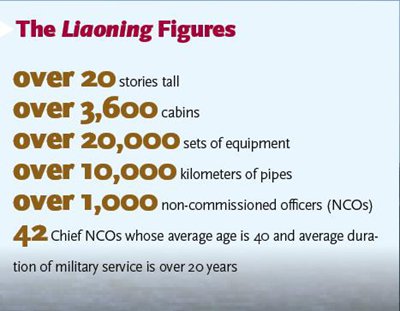
Getting on the carrier
The aircraft carrier is more than 20 stories tall and has more than 3,600 cabins, and it takes practice to learn the ropes. A young seaman told the Global Times one of his first tasks when he came onboard was to figure out how to get around. "They tell us a cabin number and test our ability to get there in a certain amount of time."
The top officials onboard have already mastered this task. They learned this through experience and the tests of time. Most of the high officials on the carrier joined at the beginning, when the military first started selecting its crew.
The qualifications were that they needed to have displayed an excellent performance in their previous work units and have performed important military missions multiple times.
Li Lixiao, director of the testing section and an official with the aviation insurance department on board, told the Global Times that the test he took to get on the carrier included math, physics and other subjects, and the interview consisted of discussions about his professional knowledge and his willingness to serve on board.
On the desk of Li Linqing, director of the transportation section of the aviation insurance department, is a computer, on which one can clearly see the ship's working and arrangement schedule, as well as its news. There are also forums organized by different departments at which staff on the carrier discuss all sorts of topics, such as "Should people be allowed to use cell phones onboard?"
Li Dongyou told the Global Times that the cell phones and wireless Internet are allowed onboard the carrier, making it convenient for workers to get in contact with the outside world when the carrier docks.
"We need them to tolerate loneliness and hardships when working onboard the carrier, but we also hope to provide our staff with a good life," he said.
He explained that soldiers have seen a lot of improvement in their conditions of employment, especially their salaries. Right now, senior NCOs receive a monthly salary of over 10,000 yuan ($1,458), and ordinary NCOs can earn more than 4,000 yuan monthly, 10 times more than they did in 2000.
Besides better treatment, the workers can now enjoy entertainment onboard as well. There are soccer and basketball teams and soldiers are allowed to go out on weekends when the carrier docks. The soldiers also organize volunteer and charity events.
Operating smoothly
The Liaoning aircraft carrier used to be the Varyag, an old Soviet ship. When China first bought the carrier from Ukraine in 1998, the People's Liberation Army Navy had no data, no plans and no blueprints available, Li Lixiao said.
The aviation insurance department is in charge of making sure all the aircraft on the carrier are running smoothly and as such it's the most important department.
The department also needs to make sure the water, electricity, gas and air onboard are all under control.
Wang Chunhui, director of the gas section of the aviation insurance department said China has never had an aircraft carrier before and never had to deal with these kinds of issues. So they had to go about solving these issues on their own.
Years ago Wang and several other crew members started following the pipes inside the carrier and in this way, they found out where all the gas pipes are located, thousands of meters of them. They also measured how large the gas tanks are.
As there were no previous examples to follow, soldiers in different departments had to cooperate and experiment several times before they can make sure operational procedures go smoothly.
For example, the last link before an aircraft takes off from the carrier is loading its ammunition. It may look simple: the ammunition is taken out of storage, transferred to the deck through a lift and loaded into the aircraft, but it's not that simple in practice.
Li Dongbing, sergeant of the ammunition insurance squadron, told the Global Times that depending on the different types of weapons being loaded, the process may differ. Also, loading onboard a carrier at sea is different from loading on land; there may be lots of movement. In order to get it right, different departments had to drill this process hundreds of times.
It's obvious that the efforts of these soldiers have paid off. From September 25, 2012 to now, the Liaoning has finished a series of "firsts."
The carrier has satisfactorily performed all of its onboard procedures for the first time, organized the first research into the carrier's combat system, and organized the first navigation training in a formation with Liaoning at its center.
In mid-August, a new group of carrier-borne aircraft pilots launched J-15 jets onboard and passed evaluations for ski-jump takeoff and landing.


















































